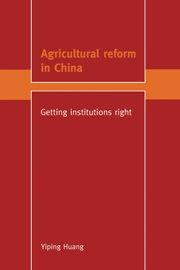Book contents
- Frontmatter
- Contents
- 1 List of figures
- 2 List of tables
- Acknowledgements
- 1 Getting markets to work in the countryside
- 2 Institutional distortions in pre-reform agriculture
- 3 Getting farmers back to work
- 4 Getting prices right
- 5 Adjustments in rural markets bring structural change
- 6 An agricultural economy without freedom to trade
- 7 China's agricultural policy choices
- 8 Chinese farmers can adapt
- 9 Getting reform right in agriculture
- Appendix: The China model
- References
- Index
2 - Institutional distortions in pre-reform agriculture
Published online by Cambridge University Press: 18 June 2010
- Frontmatter
- Contents
- 1 List of figures
- 2 List of tables
- Acknowledgements
- 1 Getting markets to work in the countryside
- 2 Institutional distortions in pre-reform agriculture
- 3 Getting farmers back to work
- 4 Getting prices right
- 5 Adjustments in rural markets bring structural change
- 6 An agricultural economy without freedom to trade
- 7 China's agricultural policy choices
- 8 Chinese farmers can adapt
- 9 Getting reform right in agriculture
- Appendix: The China model
- References
- Index
Summary
Earlier reliance on investment in heavy industry
China copied its economic system from the Soviet Union in the early 1950s (Xue 1981; World Bank 1983; Fan and Nolan 1994). The ‘Soviet model’ adopted was a comprehensive economic system implemented by bureaucratic decisions. An underlying premise of this system was that the quick road to development lay in forcing growth of heavy industries.
When Mao Zedong led the Communists to power in 1949, the new government inherited a war-torn agrarian economy. The ravages of the war had reduced production by 25 per cent in agriculture, 30 per cent in light industry and 70 per cent in heavy industry. The founding of Communist China initiated three years of rehabilitation bringing about significant recovery and dramatic growth to the economy. Grain output rose from 103 million tonnes in 1949 to 166 million tonnes in 1952. Similar rapid growth was experienced in cotton, up from 450,000 tonnes to 1.3 million tonnes, and steel, 160,000 tonnes to 1.4 million tonnes. Coal production jumped from 32 million to 66 million tonnes. The 1952 levels of output were far above the highest pre-liberalisation levels (Xue 1981: 22).
But the Chinese economy as a whole was still a poor agrarian one, particularly by international standards (Lin, Cai and Li 1994a). China had a population of nearly 600 million occupying a land area comparable in size to the United States or Canada. The majority of the population, 88 per cent, were farmers living in rural areas. Per capita grain output in 1952 was 285 kilograms, barely sufficient to support life. Agricultural production, however, accounted for about 45 per cent of total society output (TSO, shehuo zhong chanzhi).
- Type
- Chapter
- Information
- Agricultural Reform in ChinaGetting Institutions Right, pp. 17 - 37Publisher: Cambridge University PressPrint publication year: 1998

